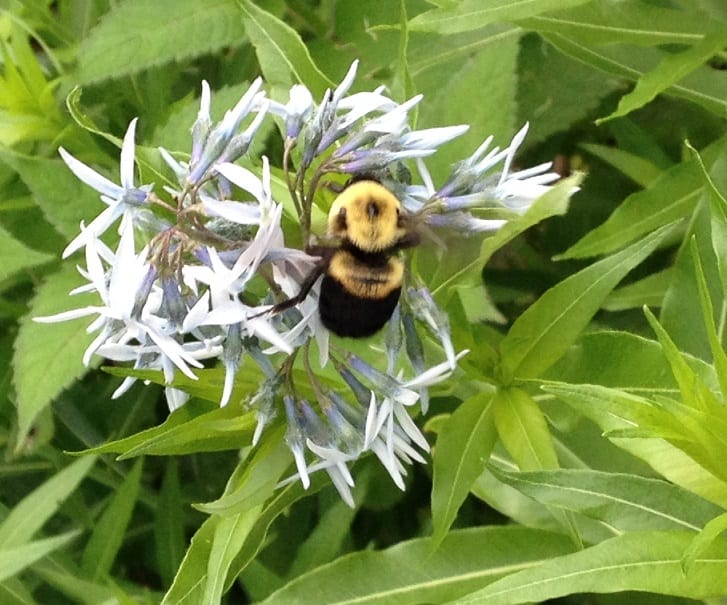As demand grows for plants that support pollinators and other wildlife, ELA reached out to a few experts to find out which species they recommend including in every landscape design.
Contributors
Carol Capobianco, Director, The Native Plant Center at Westchester Community College, Valhalla, NY
Adrian Ayres Fisher, Sustainability Coordinator, Triton College, River Grove, IL
Connie Schmotzer, Consumer Horticulture Educator, Penn State Extension, York Country, PA
Name five plants that you find critical for pollinator support and that you try to incorporate into every landscape design? What is the importance of each?

Black swallowtail caterpillar on Zizia aurea, golden alexander in our New American Cottage Garden, July 2019.
Carol: As you know, a great many native plants support pollinators. I call some of the species “LaGuardia Airport,” because the activity and diversity they attract resembles a busy transportation hub: Monarda fistulosa, Pycnathemum muticum, Clethra alnifolia, Agastache foeniculum, Symphyotrichum spp., Solidago spp. My favorite hummingbird pollinator plants are Lonicera sempervirens and Lobelia cardinalis, both with long tubular red flowers. For butterflies, of course the milkweeds and a new favorite, Zizia spp., because it is a host plant for the black swallowtail caterpillar and an early bloomer.
Adrian: This is a difficult question since different plants attract different species at different times. The following sun-loving species appeal to many species of pollinators:
- Local species of milkweed
- Spring blooming: Amsonia taburnaemontana, Tradescantia (spiderwort), Zizia aptera and Zizia aurea
- Summer blooming: Silphium perfoliatum (cup plant), Liatris, Eutrochium purpureum (Joe Pye weed)
- Fall blooming: Asters and goldenrods
- Non-native, but great for when natives aren’t blooming: Nepeta fassenii
- Annuals: Tithonia (Mexican sunflower), Cosmos “diablo,” and Zinnias. (I always recommend these annuals for people who have small spaces or even just containers, since they reliably attract bees, butterflies and hummingbirds.)
- Herbs such as dill are necessary for the swallowtail butterflies
Connie: Any of our mountain mints – especially Pycnanthemum muticum, clustered mountain mint. It was tied for number 1 in our trial for attracting the greatest diversity of pollinators. Pycnanthemum virginianum, Virginia Mountain mint is another excellent choice.
A goldenrod that is appropriate to the planting’s site conditions: Solidago rigida, stiff goldenrod, was the other plant tied for number 1 for attracting the greatest diversity of pollinators; Solidago rugosa ‘Fireworks’ is a good pollinator plant and easy to use in a design; and Solidago sphacelata ‘Golden Fleece’ is low growing and tolerant of part shade. There are many other fine goldenrods. Goldenrods are NOT the cause of hay fever! Their pollen is heavy and moved around by insects, not wind.
Milkweeds – choose one appropriate for the site. The sweet-smelling milkweed blossoms support a huge number of pollinators, and monarch caterpillars feed on the foliage. Consider Asclepias tuberosa (butterfly weed) needs full sun, poor soil and really good drainage; Asclepias incarnata, (swamp milkweed) likes moist soil, full sun to part shade; and Asclepias syriaca (common milkweed) is not choosy about site
One of the Joe Pyes – all are excellent plants for butterflies, bees and other pollinators. All like average to moist soil. Eutrochium dubium (coastal plain Joe Pye) was the Number 1 plant for attracting butterflies in our trial and also the shortest of the Joe Pye species
Culver’s root – Veronicastrum virginicum. Beautiful white spikey blossoms attract a wide range of pollinators. Like the Joe Pyes, it likes average to moist soil.
Which additional plants do you like to include to support other types of wildlife?
Carol: Trees! The world needs more trees. My interest in native plants began when I learned about the food needs of birds. So any plant that provides food and shelter for our feathered friends – whether it offer berries, nuts, seeds, nectar, nesting materials, or places to nest and rest. Most birds are insectivores, so many native species will provide them a feast. Here are a few faves: Cornus florida – my favorite tree – multi-season interest and the berries relished by birds, also Amelanchier spp., Ilex verticillata, a late-winter source of food. Pinus strobus, a cone-bearing evergreen delight. Other plants provide for them as well such as Echinacea purpurea and Panicum virgatum—goldfinch and other birds love the seed heads.
Adrian: Native species of flowering, berry-producing shrubs and small trees that provide forage and cover for birds, such as Aronia melanocarpa (chokeberry), Ribes americanum (American black current), and Cornus alternifolia (pagoda dogwood). Native bur, black, white and red oaks support a huge number of wildlife species.
Connie: Native trees and shrubs are extremely important for all wildlife, including our pollinators. Oaks support the most caterpillars that are necessary for nesting birds to feed to their young. Second to the oaks are members of the Prunus family and native willows.


